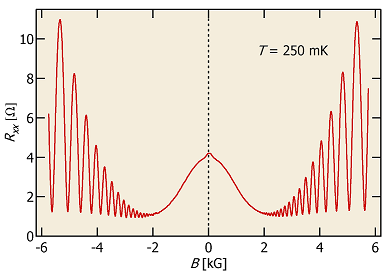Introduction to our research
In this section we provide introduction to the fundamental transport phenomena which occur in high Landau levels of two-dimensional electron systems, as well as some background information on instrumentation used in our experiments. Please use the links on the left to navigate.
If you are interested in some theoretical basics behind Shubnikov-de Haas oscillations, microwave-induced resistance oscillations, and Hall field-induced resistance oscillations, feel free to look at notes on quantum transport.
Shubnikov de-Haas Oscillations
When a 2DES is subject to weak magnetic fields B and low temperatures T, the linear response exhibits oscillations controlled by the ratio of the Fermi energy, EF, to the cyclotron energy, ħωc = eB/m [1]. These oscillations are periodic in the inverse magnetic field, 1/B, and are a result of EF sweeping through the Landau level (LL) energy spectrum. As a LL passes through EF it depopulates as the electrons become free to flow.
These oscillations are of importance due to their ability to yield information about three important physical parameters. The oscillation frequency, when plotted as a function of 1/B, characterizes the Fermi surface and gives direct examination of the carrier density. Minima of these oscillations occur at integer values of the quantity ν = neh/eB, where ne is the electron density and h and e are fundamental constants. Thus by using adjacent minima one can obtain the carrier density directly.
The other two physical parameters obtained from SdHOs are the effective mass, m*, of the charge carriers and the quantum lifetime, τq. Theoretically the amplitude of these oscillations is given by
ΔρSdHO = 4ρ0δcos(πν)X(T)/sinhX(T)
where ρ0 is the resistance at zero magnetic field and X(T) = 2π2T/ωc. By performing a temperature dependent study of SdHOs one can extract m* [2] from the thermal damping factor and performing a Dingle analysis yields the value of τq [3].

Fig. 1 This figure depicts typical form of SdHOs in our 2DESs as obtained in sweeping magnetic field with no external excitation at T = 250 mK.
References
[1] L. Shubnikov and W. de Haas, Leiden Communication 207a, 3 (1930)
[2] P. T. Coleridge, M. Hayne, P. Zawadzki, and A. S. Sachrajda, “Effective masses in high-mobility 2D electron gas structures”, Surface Science 361, 560 (1996) [abstract] [full text]
[3] P. T. Coleridge, R. Stoner, and R Fletcher, “Low-Field Transport Coefficients in GaAs/Ga1-xAlxAs Heterostructures&rduo;, Physical Review B 39, 1120 (1989) [abstract] [full text]

